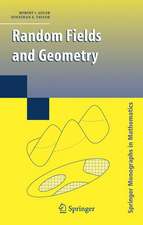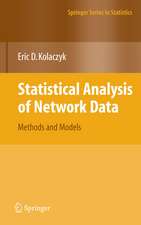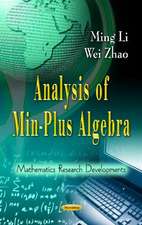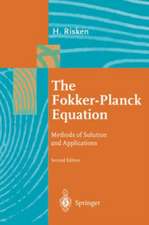Smoothness Priors Analysis of Time Series: Lecture Notes in Statistics, cartea 116
Autor Genshiro Kitagawa, Will Gerschen Limba Engleză Paperback – 9 aug 1996
Din seria Lecture Notes in Statistics
- 15%
 Preț: 631.86 lei
Preț: 631.86 lei -
 Preț: 385.84 lei
Preț: 385.84 lei - 17%
 Preț: 490.20 lei
Preț: 490.20 lei - 17%
 Preț: 460.30 lei
Preț: 460.30 lei - 18%
 Preț: 945.92 lei
Preț: 945.92 lei - 20%
 Preț: 561.44 lei
Preț: 561.44 lei - 18%
 Preț: 943.25 lei
Preț: 943.25 lei - 18%
 Preț: 943.25 lei
Preț: 943.25 lei - 18%
 Preț: 990.57 lei
Preț: 990.57 lei - 15%
 Preț: 641.38 lei
Preț: 641.38 lei -
 Preț: 428.67 lei
Preț: 428.67 lei - 15%
 Preț: 633.53 lei
Preț: 633.53 lei - 15%
 Preț: 658.88 lei
Preț: 658.88 lei -
 Preț: 383.33 lei
Preț: 383.33 lei - 15%
 Preț: 640.71 lei
Preț: 640.71 lei - 18%
 Preț: 947.18 lei
Preț: 947.18 lei - 18%
 Preț: 1007.35 lei
Preț: 1007.35 lei - 18%
 Preț: 942.63 lei
Preț: 942.63 lei - 15%
 Preț: 639.59 lei
Preț: 639.59 lei - 18%
 Preț: 1231.47 lei
Preț: 1231.47 lei - 15%
 Preț: 643.00 lei
Preț: 643.00 lei - 18%
 Preț: 886.62 lei
Preț: 886.62 lei -
 Preț: 383.12 lei
Preț: 383.12 lei - 15%
 Preț: 633.35 lei
Preț: 633.35 lei - 15%
 Preț: 635.65 lei
Preț: 635.65 lei -
 Preț: 393.74 lei
Preț: 393.74 lei - 15%
 Preț: 632.70 lei
Preț: 632.70 lei - 15%
 Preț: 637.28 lei
Preț: 637.28 lei - 15%
 Preț: 702.87 lei
Preț: 702.87 lei - 15%
 Preț: 642.68 lei
Preț: 642.68 lei - 15%
 Preț: 644.63 lei
Preț: 644.63 lei - 15%
 Preț: 645.14 lei
Preț: 645.14 lei -
 Preț: 382.36 lei
Preț: 382.36 lei - 15%
 Preț: 636.30 lei
Preț: 636.30 lei - 15%
 Preț: 647.92 lei
Preț: 647.92 lei -
 Preț: 380.63 lei
Preț: 380.63 lei - 18%
 Preț: 887.05 lei
Preț: 887.05 lei - 15%
 Preț: 634.32 lei
Preț: 634.32 lei - 15%
 Preț: 648.74 lei
Preț: 648.74 lei -
 Preț: 378.92 lei
Preț: 378.92 lei - 15%
 Preț: 648.56 lei
Preț: 648.56 lei - 15%
 Preț: 647.59 lei
Preț: 647.59 lei - 15%
 Preț: 641.20 lei
Preț: 641.20 lei - 18%
 Preț: 1102.69 lei
Preț: 1102.69 lei - 15%
 Preț: 643.16 lei
Preț: 643.16 lei -
 Preț: 384.70 lei
Preț: 384.70 lei
Preț: 780.37 lei
Preț vechi: 951.67 lei
-18% Nou
Puncte Express: 1171
Preț estimativ în valută:
149.34€ • 162.16$ • 125.45£
149.34€ • 162.16$ • 125.45£
Carte tipărită la comandă
Livrare economică 22 aprilie-06 mai
Preluare comenzi: 021 569.72.76
Specificații
ISBN-13: 9780387948195
ISBN-10: 0387948198
Pagini: 280
Ilustrații: X, 280 p.
Dimensiuni: 155 x 235 x 15 mm
Greutate: 0.4 kg
Ediția:1996
Editura: Springer
Colecția Springer
Seria Lecture Notes in Statistics
Locul publicării:New York, NY, United States
ISBN-10: 0387948198
Pagini: 280
Ilustrații: X, 280 p.
Dimensiuni: 155 x 235 x 15 mm
Greutate: 0.4 kg
Ediția:1996
Editura: Springer
Colecția Springer
Seria Lecture Notes in Statistics
Locul publicării:New York, NY, United States
Public țintă
ResearchCuprins
1 Introduction.- 1.1 Background.- 1.2 What is in the Book.- 1.3 Time Series Examples.- 2 Modeling Concepts and Methods.- 2.1 Akaike’s AIC: Evaluating Parametric Models.- 2.2 Least Squares Regression by Householder Transformation.- 2.3 Maximum Likelihood Estimation and an Optimization Algorithm.- 2.4 State Space Methods.- 3 The Smoothness Priors Concept.- 3.1 Introduction.- 3.2 Background, History and Related Work.- 3.3 Smoothness Priors Bayesian Modeling.- 4 Scalar Least Squares Modeling.- 4.1 Estimating a Trend.- 4.2 The Long AR Model.- 4.3 Transfer Function Estimation.- 5 Linear Gaussian State Space Modeling.- 5.1 Introduction.- 5.2 Standard State Space Modeling.- 5.3 Some State Space Models.- 5.4 Modeling With Missing Observations.- 5.5 Unequally Spaced Observations.- 5.6 An Information Square-Root Filter/Smoother.- 6 Contents General State Space Modeling.- 6.1 Introduction.- 6.2 The General State Space Model.- 6.3 Numerical Synthesis of the Algorithms.- 6.4 The Gaussian Sum-Two Filter Formula Approximation.- 6.5 A Monte Carlo Filtering and Smoothing Method.- 6.6 A Derivation of the Kalman filter.- 7 Applications of Linear Gaussian State Space Modeling.- 7.1 AR Time Series Modeling.- 7.2 Kullback-Leibler Computations.- 7.3 Smoothing Unequally Spaced Data.- 7.4 A Signal Extraction Problem.- 8 Modeling Trends.- 8.1 State Space Trend Models.- 8.2 State Space Estimation of Smooth Trend.- 8.3 Multiple Time Series Modeling: The Common Trend Plus Individual Component AR Model.- 8.4 Modeling Trends with Discontinuities.- 9 Seasonal Adjustment.- 9.1 Introduction.- 9.2 A State Space Seasonal Adjustment Model.- 9.3 Smooth Seasonal Adjustment Examples.- 9.4 Non-Gaussian Seasonal Adjustment.- 9.5 Modeling Outliers.- 9.6 Legends.- 10 Estimation of Time Varying Variance.- 10.1Introduction and Background.- 10.2 Modeling Time-Varying Variance.- 10.3 The Seismic Data.- 10.4 Smoothing the Periodogram.- 10.5 The Maximum Daily Temperature Data.- 11 Modeling Scalar Nonstationary Covariance Time Series.- 11.1 Introduction.- 11.2 A Time Varying AR Coefficient Model.- 11.3 A State Space Model.- 11.4 PARCOR Time Varying AR Modeling.- 11.5 Examples.- 12 Modeling Multivariate Nonstationary Covariance Time Series.- 12.1 Introduction.- 12.2 The Instantaneous Response-Orthogonal Innovations Model.- 12.3 State Space Modeling.- 12.4 Time Varying PARCOR VAR Modeling.- 12.5 Examples.- 13 Modeling Inhomogeneous Discrete Processes.- 13.1 Nonstationary Discrete Process.- 13.2 Nonstationary Binary Processes.- 13.3 Nonstationary Poisson Process.- 14 Quasi-Periodic Process Modeling.- 14.1 The Quasi-periodic Model.- 14.2 The Wolfer Sunspot Data.- 14.3 The Canadian Lynx Data.- 14.4 Other Examples.- 14.5 Predictive Properties of Quasi-periodic Process Modeling.- 15 Nonlinear Smoothing.- 15.1 Introduction.- 15.2 State Estimation.- 15.3 A One Dimensional Problem.- 15.4 A Two Dimensional Problem.- 16 Other Applications.- 16.1 A Large Scale Decomposition Problem.- 16.2 Markov State Classification.- 16.3 SPVAR Modeling for Spectrum Estimation.- References.- Author Index.













